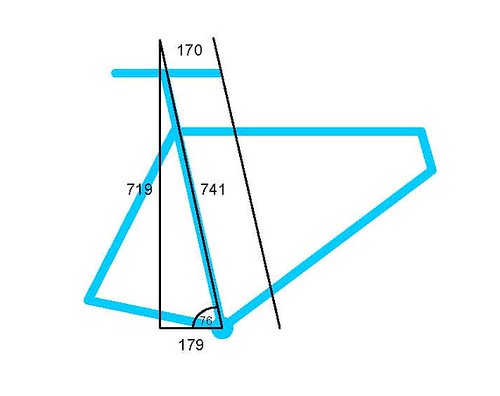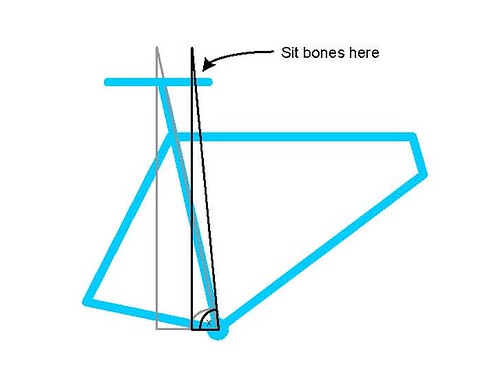I'm a bit new to this, but I've thought about the 17cm (or whatever that might be) piece before, which is for 1.3.013. I don't know if folks will agree, but it seems to me that by using 17cm
no matter what the saddle height, the shorter-legged athlete can gain more effective seat tube angle than Mr Lankypants. I'm not convinced that the 17cm shouldn't
vary subject to effective saddle height. I'll try and explain...
Take an average Joe like me with effective saddle height 741mm. I'll use that number randomly as the hypotenuse of a right-angle triangle who's angle of 76 degrees is from the horizontal (or adjacent) is centred at the bottom bracket. These numbers will give you an adjacent (distance along the horizontal to the vertical line that intersects with the hypotenuse..) of 179mm.

I don't know if it's obvious from the schematic, but the 170mm forward offset has a greater impact on the effective seat tube angle for lower saddle heights (or hypotenuseseses), and a lesser impact for higher saddle heights. If you imagine a point a little bit back from the saddle nose where you can realistically rest your sit bones, say 7cm back so 100mm forward of your 76 deg line. As you reduce the effective saddle height that position on the saddle generates a steeper and steeper angle. I did the math...
For me, as above a hypotenuse of 741mm with 76 degree angle generates an adjacent of 179mm. If you consider the above, and deduct, say, 100mm from that 179mm you have a new adjacent of 79mm. So your new effective seat tube angle is based on a hypotenuse of 741mm (unchanged, your legs haven't grown) and an adjacent of 79mm.

So for x = cos-1(adj/hyp) this gives a new effective seat tube angle for me of about 83.9 degrees.
Now if I did some similar maths based on somebody with shorter legs than me (and there aren't many), say 641mm effective saddle height, 17cm forward offset gets them an effective seat tube angle of 85 degrees. So I don't know whether the end game is to limit the effective seat tube angle, but that rule doesn't do that. You can imagine that were somebody diddy enough they could get there bum ahead of the bottom bracket.
So perhaps the thing to do is draw another line which determines what the forward offset should be at different saddle heights? I don't think it would be that difficult, you determine what the steepest effective seat tube angle is you want, then draw a parallel line to this offset by an amount equal to whatever you decide the unusable saddle tip length should be. A bit like this, in red.

So your harp becomes more of a narrow right-angled trapezoid.
Whaddya reckon? Did that make any sense at all? Apols, your question is more about 1.3.023, but here y'go anyways.
Rich.






